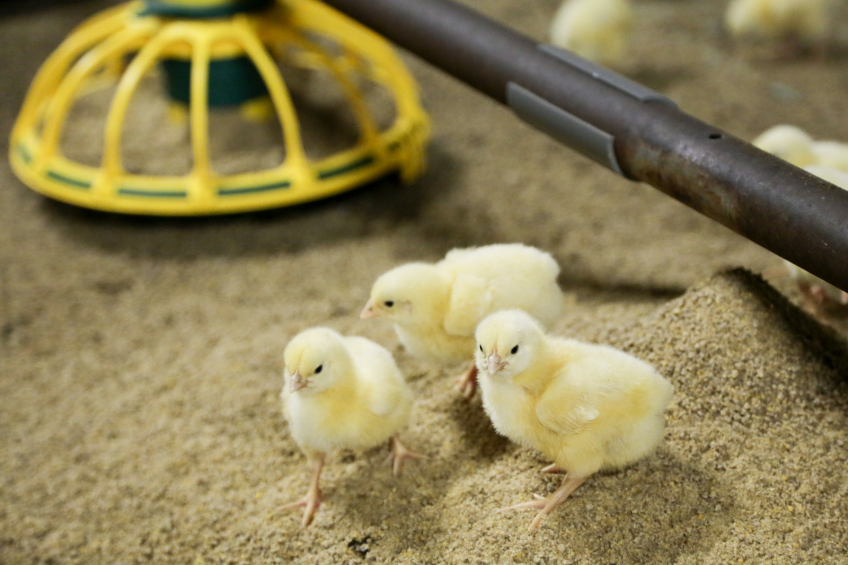How pre- and probiotics affect livestock

Professor Richard Ducatelle from the University of Ghent explains exactly how pre- and probiotics work and what the ifs and buts are in using them.
Since more and more questions are asked about the use of antibiotics in livestock farming, the use of pre-and probiotics has increased. But what are pre-and probiotics anyway?
Professor Richard Ducatelle at the Department of pathology of domestic animals of the Veterinary Faculty of the University of Ghent in Belgium, knows all of these natural resources. “Probiotics are live bacteria that are always administered directly to animals through water or food. You may only call it a probiotic when it has a beneficial effect on the health of the animal in general or specifically on the intestine.”
Prebiotics are non-digestible substances that are added to the feed with the intention of promoting good bacteria in the gut balance. In this way prebiotics have a positive impact on the overall health of an animal or specifically on the intestine. Prebiotics usually are indigestible sugars. Ducatelle: “These are unpalatable for the digestive system of the animal unless there is a sufficient number of good bacteria in the intestine. There are several groups of these good bacteria, but the most important is the group of the Firmicutes.”
On the functioning of these groups of good bacteria lots of research is done worldwide. If the number of Firmicutes in the lower part of the intestine increases, the indigestible sugars will be converted into butyric acid and propionic acid. These substances can be ingested by means of receptors in the intestinal wall and then be absorbed by the host. Both acids have all kinds of positive effects on the bowel and digestive system of animals. Thus butyric acid and to some extent also propionic acid give positive signals sent by the beneficial bacteria to the host.
A recent doctoral research shows that if 0.5% XOS is added to broiler feed the chicks have a much better feed conversion. Photo: World Poultry
What causes the increase in harmful bacteria?
As opposed to the beneficial bacteria, there are also harmful bacteria that give wrong signals. Ducatelle: “These cause inflammation in the intestinal wall. This inflammation in the intestine then causes diarrhoea. Example of a group of harmful bacteria are the Enterobacteriaceae family to which also Salmonella and Escherichia coli belong.” What causes the increase in harmful bacteria? According to Ducatelle the number one cause is the consumption of too much feed at once. At number two is feed with too high a protein content. And number three is feed with too little fibre. Fibres are indigestible sugars that good bacteria really need to propagate. “As for the three main causes of the increase in harmful bacteria in broilers all three causes play an important role, also for laying hens. Feed for broilers and laying hens contains too little fibre.” The reason for this is that the animals have to perform optimally. As a result, in the ration, as much as possible easily digestible ingredients are included. Fibres are mainly seen as ‘ballast’. The current standard broiler feed therefore only contains on average 2 to 3% of fibre. In laying hen feed the fibre content is somewhat higher.
Butyric acid essential
Until a few years ago it was thought that fibres actually were just ‘ballast’ in the feed. However, fibres turn out to play a key role with regard to the health of the animal. If the Firmicutes can digest the indigestible sugars from the fibres then butyric acid and propionic acid are produced. Ducatelle: “In the intestinal wall there are also hormone-producing cells that respond to butyric acid. When they register butyric acid, they produce natural hormones which are necessary for the development of the intestinal system and for the feeling of satiety.” If these hormones are produced in insufficient amounts, the animal will get no satiety making it eat too much. Broilers have been selected in the past, according to the professor, for increased feed intake. This has led to broilers that are constantly overeating, which in turn leads to dysbiosis or dysbacteriosis.
To prevent this, according to Ducatelle, feed needs to be formulated in order to support the beneficial bacteria which will give satiety through the production of butyrate. “It applies not only in broilers, as many people may think, but also in laying hens. There it’s called chronic enteritis.” Dysbiosis causes inflammation in the gut which then leads to diarrhoea, resulting in dirty eggs.
Pre- and probiotics solution
The beneficial bacteria in the gut can be stimulated by increasing the fibre content of the feed. Ducatelle: “Increasing the amount of fibre in broiler feed to 10%, however, is not realistic. Then the animals get too little nutrients to support the meat production and grow too slowly.” Yet there is a solution to the problem. That is, pre-and probiotics. “Prebiotics like fibres are indigestible sugars. The benefit of prebiotics, however, is that the sugars are actually already predigested. In other words, are ready to be digested by the good bacteria to from butyric acid and propionic acid.”
The principle of probiotics is that you add beneficial bacteria directly to the ration. Ducatelle: “The best probiotics are however not available because the bacteria that produce butyric acid and propionic acid are extremely difficult to grow in a laboratory, let alone produce in large enough amounts for the production of all broilers.” So there are two options left according to the professor. Either direct application of butyric acid or propionic acid to the ration. There are currently many types of these acids on the market. Yet Ducatelle places a number of caveats when using. “Simple butyric- and propionic acids or salts in powder form are not suitable. The acids must be protected against digestion at the front of the digestive system through a coating or in glyceride form. Otherwise they will not reach the Firmicutes which are in the lower part of the intestine.” Hence only coated butyric- or propionic acid products or butyric- and propionic acid products in glyceride form can be used.
| Richard Ducatelle (60) University of Ghent Ducatelle is a professor at the Department of Pathology of the Veterinary Faculty of the University of Ghent and conducts research into the mechanisms of pre- and probiotics in broilers. |
Butyric acid most efficient
Various scientific publications worldwide show that butyric acid works even more efficiently than propionic acid. Butyric acid actually gives a signal to the cells. Though it is at present still virtually impossible to add butyrate bacteria to the poultry ration, in the future this will be possible. Ducatelle: “I expect within five to ten years. This will also greatly depend on the poultry sector itself and the periphery of this sector. How strong is the incentive to produce without antibiotics?” According to him, the sector is currently still in the process of suppressing harmful bacteria with antibiotics.
In addition to coated butyric and propionic acid there are also the lactobacilli resources like probiotics. Ducatelle: “Lactobacilli, however, have a different effect. They break the same indigestible sugars into lactic acid. Lactic acid in itself is not useful. On the contrary, it can even be harmful or dangerous in high concentrations.” However, there are certain kinds of Firmicutes that can turn lactic acid into butyric acid. Then adding lactobacilli can be useful. “You can do little wrong with lactobacilli resources, but the chance that it realises a beneficial effect is very small.” Scientific research shows that there are more situations when lactobacilli in the intestine are too numerous than too little.
Research Ghent University
Many different prebiotics are now on the market. According to the professor for most products the exact mechanism of action is either completely unknown or only partially explained. “There is still no research into the exact mode of action of many prebiotics, hence that is what we, at University of Ghent, are doing currently.” Of only two prebiotics the scientific mechanism is largely known. This includes XOS (Xylio Oligo Saccharides) and AXOS (Arabino Xylan Oligo Saccharides). The mechanism of inulin is partially already unravelled.
A recent doctoral research shows that if 0.5% XOS is added to the broiler feed the chicks have a much better feed conversion. Ducatelle: “Our research showed that XOS stimulates the lactobacilli which in turn stimulate the butyrate bacteria.” Yet it still is very limited according to Ducatelle, a lot more research needs to be done in order to explain the mode of action of all other prebiotics. “There is still a world to win, but there is incredibly much future perspective in it, also in the context of animal welfare and animal health.” According to the professor, it is also important to assess the quantities of prebiotics you can use. “This is also important, because you can give too much. Then the bacteria can also come at the front of the small intestine and that is harmful. Research on the right amount is therefore just as important as sifting through the exact mechanism of action.”
Source: World Poultry magazine. Volume 32.1 (2016)












